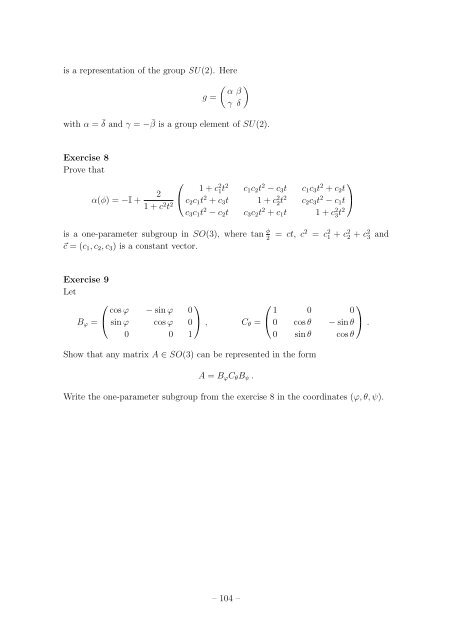Student Seminar: Classical and Quantum Integrable Systems
Student Seminar: Classical and Quantum Integrable Systems
Student Seminar: Classical and Quantum Integrable Systems
Create successful ePaper yourself
Turn your PDF publications into a flip-book with our unique Google optimized e-Paper software.
is a representation of the group SU(2). Here<br />
g =<br />
( ) α β<br />
γ δ<br />
with α = ¯δ <strong>and</strong> γ = − ¯β is a group element of SU(2).<br />
Exercise 8<br />
Prove that<br />
⎛<br />
1 + c<br />
2<br />
2 1t 2 c 1 c 2 t 2 − c 3 t c 1 c 3 t 2 ⎞<br />
+ c 2 t<br />
α(φ) = −I + ⎝ c<br />
1 + c 2 t 2 2 c 1 t 2 + c 3 t 1 + c 2 2t 2 c 2 c 3 t 2 − c 1 t ⎠<br />
c 3 c 1 t 2 − c 2 t c 3 c 2 t 2 + c 1 t 1 + c 2 3t 2<br />
is a one-parameter subgroup in SO(3), where tan φ 2 = ct, c2 = c 2 1 + c 2 2 + c 2 3 <strong>and</strong><br />
⃗c = (c 1 , c 2 , c 3 ) is a constant vector.<br />
Exercise 9<br />
Let<br />
⎛<br />
cos ϕ − sin ϕ<br />
⎞<br />
0<br />
⎛<br />
1 0<br />
⎞<br />
0<br />
B ϕ = ⎝ sin ϕ cos ϕ 0 ⎠ , C θ = ⎝ 0 cos θ − sin θ ⎠ .<br />
0 0 1<br />
0 sin θ cos θ<br />
Show that any matrix A ∈ SO(3) can be represented in the form<br />
A = B ϕ C θ B ψ .<br />
Write the one-parameter subgroup from the exercise 8 in the coordinates (ϕ, θ, ψ).<br />
– 104 –

















